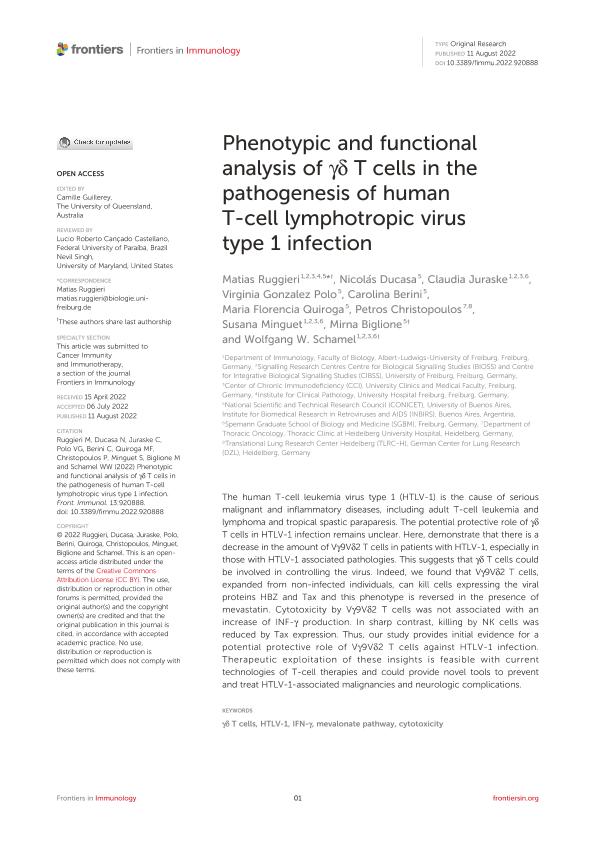Artículo
Phenotypic and functional analysis of γδ T cells in the pathogenesis of human T-cell lymphotropic virus type 1 infection
Ruggieri, Matias ; Ducasa, Nicolás; Juraske, Claudia; Gonzalez Polo, Virginia
; Ducasa, Nicolás; Juraske, Claudia; Gonzalez Polo, Virginia ; Berini, Carolina Andrea
; Berini, Carolina Andrea ; Quiroga, María Florencia
; Quiroga, María Florencia ; Christopoulos, Petros; Minguet, Susana; Biglione, Mirna Marcela
; Christopoulos, Petros; Minguet, Susana; Biglione, Mirna Marcela ; Schamel, Wolfgang W.
; Schamel, Wolfgang W.
 ; Ducasa, Nicolás; Juraske, Claudia; Gonzalez Polo, Virginia
; Ducasa, Nicolás; Juraske, Claudia; Gonzalez Polo, Virginia ; Berini, Carolina Andrea
; Berini, Carolina Andrea ; Quiroga, María Florencia
; Quiroga, María Florencia ; Christopoulos, Petros; Minguet, Susana; Biglione, Mirna Marcela
; Christopoulos, Petros; Minguet, Susana; Biglione, Mirna Marcela ; Schamel, Wolfgang W.
; Schamel, Wolfgang W.
Fecha de publicación:
08/2022
Editorial:
Frontiers Media
Revista:
Frontiers in Immunology
ISSN:
1664-3224
e-ISSN:
1664-3224
Idioma:
Inglés
Tipo de recurso:
Artículo publicado
Clasificación temática:
Resumen
The human T-cell leukemia virus type 1 (HTLV-1) is the cause of serious malignant and inflammatory diseases, including adult T-cell leukemia and lymphoma and tropical spastic paraparesis. The potential protective role of γδ T cells in HTLV-1 infection remains unclear. Here, demonstrate that there is a decrease in the amount of Vγ9Vδ2 T cells in patients with HTLV-1, especially in those with HTLV-1 associated pathologies. This suggests that γδ T cells could be involved in controlling the virus. Indeed, we found that Vγ9Vδ2 T cells, expanded from non-infected individuals, can kill cells expressing the viral proteins HBZ and Tax and this phenotype is reversed in the presence of mevastatin. Cytotoxicity by Vγ9Vδ2 T cells was not associated with an increase of INF-γ production. In sharp contrast, killing by NK cells was reduced by Tax expression. Thus, our study provides initial evidence for a potential protective role of Vγ9Vδ2 T cells against HTLV-1 infection. Therapeutic exploitation of these insights is feasible with current technologies of T-cell therapies and could provide novel tools to prevent and treat HTLV-1-associated malignancies and neurologic complications.
Palabras clave:
CYTOTOXICITY
,
HTLV-1
,
IFN-Γ
,
MEVALONATE PATHWAY
,
ΓΔ T CELLS
Archivos asociados
Licencia
Identificadores
Colecciones
Articulos(INBIRS)
Articulos de INSTITUTO DE INVESTIGACIONES BIOMEDICAS EN RETROVIRUS Y SIDA
Articulos de INSTITUTO DE INVESTIGACIONES BIOMEDICAS EN RETROVIRUS Y SIDA
Citación
Ruggieri, Matias; Ducasa, Nicolás; Juraske, Claudia; Gonzalez Polo, Virginia; Berini, Carolina Andrea; et al.; Phenotypic and functional analysis of γδ T cells in the pathogenesis of human T-cell lymphotropic virus type 1 infection; Frontiers Media; Frontiers in Immunology; 13; 8-2022; 1-15
Compartir
Altmétricas



